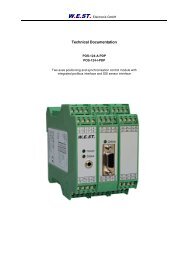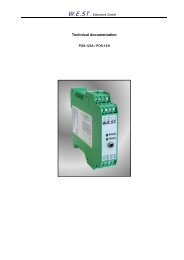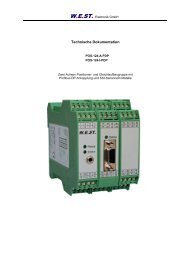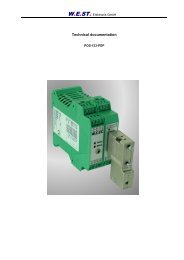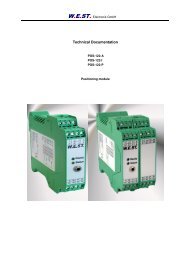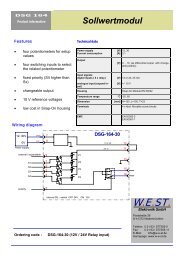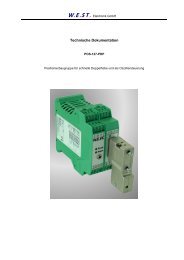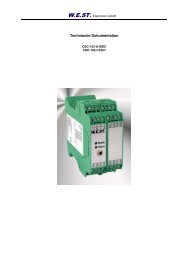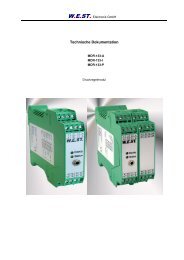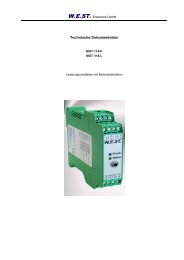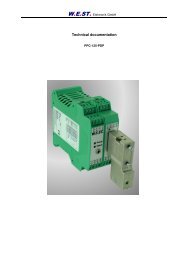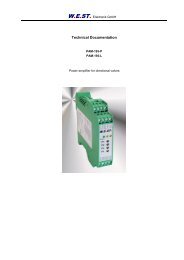Technical documentation - W.E.ST. Elektronik GmbH
Technical documentation - W.E.ST. Elektronik GmbH
Technical documentation - W.E.ST. Elektronik GmbH
Create successful ePaper yourself
Turn your PDF publications into a flip-book with our unique Google optimized e-Paper software.
W.E.<strong>ST</strong>. <strong>Elektronik</strong> <strong>GmbH</strong><br />
<strong>Technical</strong> <strong>documentation</strong><br />
PAM-197
W.E.<strong>ST</strong>. <strong>Elektronik</strong> <strong>GmbH</strong><br />
Inhaltsverzeichnis<br />
Revisions ...................................................................................................................................................... 3<br />
Ordering code ............................................................................................................................................... 3<br />
Accessories .................................................................................................................................................. 3<br />
General description....................................................................................................................................... 4<br />
General installation remarks......................................................................................................................... 5<br />
In- and outputs ..................................................................................................................................... 6<br />
LED Funktion ....................................................................................................................................... 6<br />
Block diagram ...................................................................................................................................... 7<br />
Typical wiring ....................................................................................................................................... 8<br />
<strong>Technical</strong> Data ..................................................................................................................................... 9<br />
Dimensions ........................................................................................................................................ 9<br />
General IO description ....................................................................................................................... 10<br />
Power supply ................................................................................................................................... 10<br />
Digital inputs .................................................................................................................................... 10<br />
Digital outputs .................................................................................................................................. 10<br />
Analogue inputs ............................................................................................................................... 11<br />
PWM outputs ................................................................................................................................... 11<br />
Serial interface................................................................................................................................. 11<br />
Start-up and commissioning guidelines ................................................................................................. 12<br />
Parameter table...................................................................................................................................... 13<br />
Parameter description ............................................................................................................................ 15<br />
S (setpoint parameterization)........................................................................................................... 15<br />
RMODE (ramp- function mode)....................................................................................................... 15<br />
RA (ramptime parameterization)...................................................................................................... 15<br />
MODE (of the linearization) ............................................................................................................. 16<br />
CC (characteristic linearization)....................................................................................................... 16<br />
RCURR (real current input) ............................................................................................................. 17<br />
MIN (compensation of the dead zone) ............................................................................................ 18<br />
MAX (maximum output signal)......................................................................................................... 18<br />
TRIGGER (threshold value of MIN)................................................................................................. 18<br />
SENS (sensor monitoring) ............................................................................................................... 19<br />
SOLENOIDS (number of solenoids)................................................................................................ 19<br />
CURRENT (range of the output current) ......................................................................................... 19<br />
DFREQ / DAMPL (dither frequency, dither amplitude).................................................................... 19<br />
PWM (pwm output frequency) ......................................................................................................... 20<br />
PPWM / IPWM (P-gain and i-gain of the current compensator)...................................................... 20<br />
CMODE (function of the output stage) ............................................................................................20<br />
SAVE (data storing in EEPROM)..................................................................................................... 21<br />
LOADBACK (copy of the EEPROM into the active RAM) ............................................................... 21<br />
DEFAULT (parameter reset)............................................................................................................ 21<br />
PROCESS DATA (monitoring) ........................................................................................................ 21<br />
Remarks ..................................................................................................................................................... 22<br />
Seite 2 von 22 12.03.2008
Revisions<br />
W.E.<strong>ST</strong>. <strong>Elektronik</strong> <strong>GmbH</strong><br />
Datum Modul Revision Kommentar<br />
27.3.2007 7 Hardware based on DigiPAM<br />
Ordering code<br />
PAM-197-1*<br />
Alternative products<br />
PAM-196 - two independent channels for pressure or throttle valves<br />
PAM-195 - for directional valves<br />
* = Version number, for ordering not necessary. Changes of the last digit (13 to 14) indicate technical improvements<br />
at 100% compatibility. Changes from 13 to 20 indicate significant technical improvements. In<br />
this case check the <strong>documentation</strong> about the parameter and wiring.<br />
Accessories<br />
RS232-SO - programming cable with RS232C interface<br />
USB-SO - programming cable with USB interface<br />
HHT-302 - Hand held terminal<br />
W.E.<strong>ST</strong>. <strong>Elektronik</strong> <strong>GmbH</strong><br />
Poststraße 26<br />
D-41372 Niederkrüchten<br />
Fax.: +49 (0) 2163 57 73 55 - 11<br />
Homepage: www.w-e-st.de or www.west-electronics.com<br />
EMAIL: info@w-e-st.de<br />
Date: 11.03.07<br />
Revision: 8<br />
The right of changes are reserved.<br />
Seite 3 von 22 12.03.2008
General description<br />
W.E.<strong>ST</strong>. <strong>Elektronik</strong> <strong>GmbH</strong><br />
This module is used for the control of proportional valves with one or two solenoids (directional valves).<br />
Various adjustable parameters enable an optimized adaptation to the respective valve.<br />
The dynamic integrated power amplifier with a control/cycle time of 0,167 ms is inexpensive and a spacesaving<br />
solution.<br />
The power amplifier is controlled by an enable input and three switch signals. Therefore 8 demand values<br />
can be activated binary. In case of direct control (non binary) it is par example possible to preset the directions<br />
with two inputs and to switch over between rapid and slow speed with the third input. The output<br />
current is closed loop controlled and therefore independent from the supply voltage and the solenoid resistance.<br />
The current output is observed with regard to cable breakdown and over current (short circuit).<br />
Programmable are ramps, MIN and MAX, DITHER (frequency and amplitude) and PWM frequency.<br />
The adjustment via RS232C is simple and easy, so that a short training period can be guaranteed.<br />
Typical applications: Rapid and slow speed controls and digital selectable set points for pressure and flow<br />
rate values.<br />
Features<br />
• For proportional valves with one or two solenoids<br />
• Three switch inputs for the selection of 8 programmed demand values<br />
• Compact housing<br />
• Digital reproducible adjustments<br />
• Characteristic linearization via 10 XY-points per direction<br />
• Free parametering of ramps, MIN und MAX current, Dither (frequency, amplitude)<br />
and PWM frequency<br />
• Adjustment MIN / MAX in mA<br />
• Current range (per software adaptable): 1 A, 1,6 A and 2,6 A<br />
• Simple and application orientated parameter settings<br />
• Fehler Diagnostik und erweiterte Funktionsüberprüfung<br />
• Failure monitoring<br />
• Adjustments via RS232C interface<br />
Seite 4 von 22 12.03.2008
General installation remarks<br />
Explanation of terms and notes on safety<br />
Terms:<br />
W.E.<strong>ST</strong>. <strong>Elektronik</strong> <strong>GmbH</strong><br />
w: command signal<br />
c: internal signal<br />
u: internal signal<br />
ia, ib: output current (not scaled, only for information)<br />
Mounting instructions<br />
This module is for the installation provided in shielded electromagnetic compatibility housing (EMC conform).<br />
All cables operating outside have to be screened. A complete shielding is presupposed. It is also presupposed,<br />
that no strong electrical disturbances near the module are installed.<br />
Typical mounting area: 24V control signal area (near PLC)<br />
By the arrangement of the electrical cabinet a separation between power part (and power cables) and<br />
signal part must be taken in consideration. Experience shows us that the area next to the PLC (24 V<br />
area) is suitable. All digital and analogue inputs and outputs have filters and an over voltage protection. In<br />
case of correct wiring and shielding all EMC demands are fulfilled. If there are nevertheless any problems,<br />
please send us detailed sketches of mounting and wiring. We will look after this problem immediately.<br />
Even if all EMC-norms are fulfilled, technical problems in special cases are possible. Our experience has<br />
shown us that most of these problems are caused in the physical conditions of the cables. If everything is<br />
shielded continuously and configured correctly, no problems have to be expected.<br />
ATTENTION!<br />
ATTENTION!<br />
Due to electrical disturbances, failure at components as well as software faults can cause<br />
in individual cases uncontrolled movements at the drive. Appropriate safety precautions<br />
have to be considered during the engineering.<br />
Connection and start up of the module may only be allowed by qualified<br />
persons who have, because of education, experience and instruction, sufficient<br />
acknowledge on relevant directives and approved technical rules.<br />
Please read and follow the operating instructions carefully. In case of non<br />
observance of the instruction the guaranty and liability claim expires.<br />
Seite 5 von 22 12.03.2008
In- and outputs<br />
W.E.<strong>ST</strong>. <strong>Elektronik</strong> <strong>GmbH</strong><br />
Terminal Description of the analogue inputs and outputs<br />
PIN 1 / 2 und<br />
PIN 3 / 4<br />
LED Funktion<br />
PWM outputs for solenoid control. Solenoid B,<br />
Solenoid A.<br />
Terminal Description of the analogue inputs and outputs<br />
PIN 15 Enable input:<br />
This digital input signal initializes the application. The power output is active and<br />
the READY signal indicates that all components are working correctly.<br />
Error conditions are disabling by ENABLE<br />
PIN 6 / 9 / 14 Digital control inputs to retrieve the appropriate setpoints. All setpoints, in a storage<br />
area be deposited, can be linked binary. S1: Pin 6, S2: Pin 9, S4: Pin 14.<br />
setpoint 0: S1 = 0, S2 = 0, S4 = 0<br />
setpoint 1: S1 = 1, S2 = 0, S4 = 0<br />
setpoint 2: S1 = 0, S2 = 1, S4 = 0<br />
setpoint 3: S1 = 1, S2 = 1, S4 = 0<br />
setpoint 4: S1 = 0, S2 = 0, S4 = 1<br />
setpoint 5: S1 = 1, S2 = 0, S4 = 1<br />
setpoint 6: S1 = 0, S2 = 1, S4 = 1<br />
setpoint 7: S1 = 1, S2 = 1, S4 = 1<br />
Pin 5 READY output:<br />
General operational, ENABLE is active and there is no input error (by use of 4…<br />
20 mA input) or solenoid error. This output corresponds with the green LED.<br />
LEDs Description of the LED function<br />
GREEN Corresponding with the READY output.<br />
OFF: No power supply or ENABLE is not activated<br />
ON: System is ready<br />
FLASHING: A failure is detected.<br />
(4… 20 mA input) signal is out of the range or<br />
short cut / broken cable to the solenoids<br />
YELLOW The intensity indicates the rate of output current.<br />
Seite 6 von 22 12.03.2008
Block diagram<br />
Power supply<br />
12 /24 V<br />
0V<br />
7<br />
8<br />
PAM-197-*<br />
3,5 mm JISC-6560<br />
24 V<br />
DC<br />
0 V<br />
DC<br />
8 V<br />
5 V<br />
RS232 C<br />
9600 Baud<br />
W.E.<strong>ST</strong>. <strong>Elektronik</strong> <strong>GmbH</strong><br />
3<br />
ia<br />
A<br />
4<br />
A-solenoid<br />
ib<br />
Ramps<br />
ra:i x<br />
W Linearisation C<br />
i = 1... 7<br />
x = 5... 60000 CC:i x y<br />
2<br />
B<br />
1<br />
min:i x <br />
i = A | B<br />
x = 0..5000<br />
max:i x <br />
i = A | B<br />
x = 5000..10000<br />
trigger x <br />
x = 0... 2000<br />
Values<br />
s:i x<br />
i = 1... 7<br />
x = -10000... 10000<br />
13<br />
10<br />
11<br />
CONFIGURATION<br />
mode x (x = ON|OFF)<br />
cmode x (x= ON|OFF)<br />
rmode x (x= SD|4Q)<br />
rcurr x (x= ON|OFF)<br />
sens x (x= ON|OFF)<br />
solenoids x (1|2)<br />
Seite 7 von 22 12.03.2008<br />
B-solenoid<br />
A-solenoid<br />
3<br />
pwm x <br />
x = 80..3900<br />
ipwm x <br />
x = 2..100<br />
ppwm x <br />
x = 0..7<br />
dfreq:i x <br />
i = A | B<br />
x = 60..400<br />
dampl:i x <br />
i = A | B<br />
x = 0..1500<br />
current: x<br />
x = 0|1|2<br />
Power stage<br />
U<br />
mode = on<br />
Auswahl<br />
Auswahl<br />
12 8 V ref.<br />
4<br />
General commands<br />
Control program<br />
2<br />
B-solenoid<br />
DIAGNO<strong>ST</strong>ICS<br />
din <br />
w, c <br />
u <br />
ia, ib <br />
S1<br />
digital input<br />
S2 9 digital input<br />
6<br />
5<br />
Ready output<br />
Wiring for valves<br />
in three wire technology<br />
(HAWE)<br />
PE via DIN-RAIL<br />
SUPPORT<br />
save <br />
loadback <br />
help <br />
para <br />
default <br />
id <br />
S4 14 digital input<br />
digital input<br />
15<br />
Enable
Typical wiring<br />
Betriebsbereitschaft<br />
operating state<br />
Sollwertauswahl<br />
command value select<br />
S1<br />
S2<br />
S4<br />
-<br />
Schirm /<br />
Screen<br />
W.E.<strong>ST</strong>. <strong>Elektronik</strong> <strong>GmbH</strong><br />
PE<br />
1<br />
5<br />
9<br />
13<br />
2<br />
6<br />
10<br />
14<br />
0V<br />
Seite 8 von 22 12.03.2008<br />
3<br />
7<br />
11<br />
15<br />
4<br />
8<br />
12<br />
16<br />
PE<br />
V ref.<br />
Enable<br />
Magnet B<br />
Solenoid B<br />
Magnet A<br />
Solenoid A<br />
12 V / 24 V<br />
0V<br />
Spannungsversorgung<br />
Power Supply
<strong>Technical</strong> Data<br />
Power supply<br />
Current consumption<br />
External fuse<br />
W.E.<strong>ST</strong>. <strong>Elektronik</strong> <strong>GmbH</strong><br />
[VDC]<br />
[mA]<br />
[A]<br />
Digital inputs [V]<br />
[V]<br />
Digital outputs [V]<br />
[V]<br />
Reference voltages [V]<br />
[mA]<br />
PWM outputs<br />
max. load<br />
Frequency<br />
Sample time (signal conditioning)<br />
Sample time (current control loop)<br />
12… 30 (inkl. Rippel)<br />
80 + Magnetstrom<br />
3 flink<br />
logik 0: < 2 V<br />
logik 1: > 10 V<br />
logik0: < 2 V<br />
logik 1: > 12 V (50 mA)<br />
Seite 9 von 22 12.03.2008<br />
[A]<br />
[Hz]<br />
[ms]<br />
[ms]<br />
8<br />
5<br />
1,0, 1,6 or 2,6 (per software switchable)<br />
(alternative adjustable in mA steps)<br />
100… 7700 adjustable PWM frequency<br />
1<br />
0,1667<br />
Interface RS 232C, 9600 Baud, 1 stopbit, No parity,<br />
Echo Mode<br />
Housing Snap-On Module EN 50022<br />
Polyamid PA 6.6<br />
Combustibility class V0 (UL94)<br />
Protection class<br />
Temperature range<br />
Humidity<br />
IP<br />
°C<br />
%<br />
Dimensions (width9 [mm] 22,5<br />
20<br />
-20..55<br />
W.E.<strong>ST</strong>. <strong>Elektronik</strong> <strong>GmbH</strong><br />
General IO description<br />
This description is a general description of the technical data of out open loop and closed loop control<br />
modules. Please check the implemented IO signals via the block diagram about availability.<br />
Power supply<br />
This module is designed for 10… 30 VDC (typical 12 V or 24 V) of a power supply. This power supply<br />
must correspond to the actual EMC standards.<br />
All inductivities at the same power supply (relays, valves …) must be provided with an over voltage protection<br />
(varistors, free-wheel diodes …).<br />
It is recommended to use a regulated power supply (linear or switching mode) for the supply of the module<br />
and the sensors. These power supplies have a clearly lower internal resistance in comparison with<br />
non regulated power supplies and therefore a better spurious rejection.<br />
Power supply : 10… 30 VDC, incl. ripple<br />
Power consumption: 100 mA + solenoid current consumption<br />
External protection: 5 A fast<br />
ATTENTION: Without an external fuse and in case of a continual short-circuit the<br />
module can be destroyed in spite of all internal protections.<br />
Digital inputs<br />
The digital inputs are designed for a voltage level of 12 V and 24 V. The typical connections to the PLC<br />
will not be screened if the modules are arranged carefully and with short cable lengths. As common potential<br />
0V (PIN 4) is used.<br />
All inputs are protected with suppressor diodes and RC-filters against transient overshoots.<br />
Low level: < 2 V<br />
High level: > 10 V<br />
Current: < 0,1 mA<br />
Digital outputs<br />
The digital outputs are designed for a voltage level of 12 V and 24 V. The typical connections to the PLC<br />
will not be screened if the modules are arranged carefully and with short cable lengths. As common potential<br />
0V (PIN 4) is used.<br />
All outputs are protected with suppressor diodes and RC-filters against transient overshoots.<br />
Low level: < 2 V<br />
High level: > 10 V<br />
Current: max. 50 mA (with load of 200 Ohm)<br />
Seite 10 von 22 12.03.2008
W.E.<strong>ST</strong>. <strong>Elektronik</strong> <strong>GmbH</strong><br />
Analogue inputs<br />
The analogue inputs are designed for a maximum voltage range of 10 V. The voltage input is typically<br />
±10 V and the current input is 4… 20 mA with 12 mA for the center position of the directional valve.<br />
The inputs are protected with suppressor diodes (level 33 V) and RC-filter against transient overshoots.<br />
All analogue inputs must be screened.<br />
Differential input:<br />
Voltage level: unipolar 0… 10 V to PIN 9 / PIN 10 and 0…10 V to PIN 13 / PIN 14<br />
input resistance: 100 kΩ<br />
Current level: unipolar 4… 20 mA (PIN 9 to PIN 10 / PIN13 to PIN14)<br />
input resistance: app. 390 Ω<br />
Cable break down are monitored via the READY output and a flashing<br />
green LED.<br />
PWM outputs<br />
The output current is controlled via closed loop PWM current controller with PI characteristics. For high<br />
flexibility PWM frequency, dither frequency, dither amplitude and the PI compensator are free configurable.<br />
Cable break down and short cuts are monitored via the READY output and a flashing green READY<br />
LED.<br />
The outputs are protected with suppressor diodes (level 33 V) and RC-filter against transient overshoots.<br />
PWM:<br />
Output current: max. 2,6 A 1<br />
Frequency: 100… 7700 Hz<br />
Serial interface<br />
The serial interface is chosen for the parametering with a PC or a notebook. A suitable cable of 3,5mm<br />
JISC-6560 plug to 9pol. RS232 (PC compatible) can be bought under RS232-SO.<br />
You can parameterize our modules with each terminal program. However, by use of our application software<br />
WPC-300 you have enlarged functions and therefore it is preferable.<br />
Download: WWW.WE<strong>ST</strong>-ELECTRONICS.COM or WWW.W-E-<strong>ST</strong>.DE<br />
Features:<br />
• Table orientated parametering<br />
• Saving and loading of the parameter sets<br />
• Process data monitoring<br />
• Oscilloscope for dynamical optimization of the control parameters<br />
• Terminal window for flexible data input<br />
1<br />
The output current can be adjusted in % of the rated current or directly in mA. In case of mA adjustment, the “current”<br />
command should not be used.<br />
Seite 11 von 22 12.03.2008
W.E.<strong>ST</strong>. <strong>Elektronik</strong> <strong>GmbH</strong><br />
Start-up and commissioning guidelines<br />
1. The module must be mounted and wired with attentions to EMC requirements. A star orientated<br />
ground connection should be used when other power consumers are sharing the same power<br />
supply. Following points have to be taken in account for wiring:<br />
• Signal cable and power cable have to be wired separately.<br />
• Analogue signal cables must be screened.<br />
• Other cables should be screened in case of strong electrical disturbance (power relays,<br />
frequency controlled power driver) and cable lengths > 3m. With high frequency EMI inexpensive<br />
ferrite elements can be used. In this typical configuration of installation (see<br />
point 2 to 4), no extra step should be taken in consideration.<br />
2. By the arrangement of the electrical cabinet a separation between the power part (and power cables)<br />
and signal part must be taken in consideration. Experience shows us that the area next to<br />
the PLC (24 V area) is suitable.<br />
3. Low impedance between PE “protected earth” and DIN-Rail should be used. Transient interference<br />
voltages at the terminals are discharged via DIN-Rail to the local PE. The screens have to<br />
be connected directly next to the module via PE terminals.<br />
4. The power supply should be carried out voltage regulated (i. e. PWM controlled). The low impedance<br />
of controlled power supplies facilitates improved interference damping. Therefore the signal<br />
resolution will be increased. Switched inductance (relays and solenoids) operating from the same<br />
power supply has to be damped by surge protection elements directly by the inductance.<br />
5. No plugs with freewheeling diodes, LEDs or other electronics should be used. The freewheeling<br />
diode is integrated in the power stage of the module.<br />
Caution: Using of electronic components in the plugs will destabilize the current<br />
control loop. The power stage can be damaged<br />
Seite 12 von 22 12.03.2008
Parameter table<br />
W.E.<strong>ST</strong>. <strong>Elektronik</strong> <strong>GmbH</strong><br />
Kommando Parameter Vorgabe Einheit Beschreibung<br />
s:i x i = 0… 7<br />
x = -10000… 10000<br />
- 0,01% Command values depending on the external signal S1, S2 and S4<br />
rmode x x= SD|4Q SD - Ramp function:<br />
SD = ramp time related to the setpoint value<br />
4Q = Four quadrants ramp, ramp-variable RA:1 to RA:4 is used.<br />
ra:i x i= 0… 7<br />
x= 0..600000<br />
100 ms Ramp-time.<br />
4Q Ramp RA:1 up (solenoid A), RA:2 down (solenoid A)<br />
RA:3 up (solenoid B), RA:4 down (solenoid B)<br />
SD Ramp RA:0 to RA:7<br />
mode x x= on|off off - Activation or deactivation of the linearization defined by the CC<br />
command.<br />
cc:i x y i= -10… 10<br />
x -10000… 10000<br />
y -10000… 10000<br />
0,01%<br />
0,01%<br />
Characteristic linearization.<br />
rcurr x x= on|off off - Real current input. MIN and MAX will be typed in, in mA. If rcurr =<br />
on; the command “current” should not be used.<br />
min:i x i= A<br />
x= 0..5000<br />
max:i x i= A<br />
x= 300..10000<br />
0<br />
10000<br />
0,01% / mA<br />
0,01% / mA<br />
Deadband compensation of positive overlapped proportional<br />
valves.<br />
Maximum output range for adapting control range to maximum<br />
flow range.<br />
trigger x x= 0..2000 200 0,01% Point to activate the deadband compensation (min). Also useful<br />
for reduced sensitivity in position with control valves.<br />
sens x x= ON|OFF ON - Activation of the sensor and internal failure monitoring.<br />
solenoids x x= 1|2<br />
current:i x i= A<br />
x= 0, 1, 2<br />
dampl:i x i= A<br />
x= 0..2000<br />
dfreq:i x i= A<br />
x= 60… 400<br />
pwm:i x i= A<br />
x= 100..7700<br />
ppwm:i x<br />
ipwm:i x<br />
x= 1… 20<br />
x= 5… 100<br />
2 - Number of used solenoids. Two for directional valves, one for<br />
pressure or throttle valves.<br />
0<br />
400<br />
120<br />
2600<br />
7<br />
40<br />
-<br />
0,01%<br />
Hz<br />
Hz<br />
-<br />
-<br />
Output current range.<br />
0 = 1,0 A range<br />
1 = 1,6 A range<br />
2 = 2,6 A range<br />
DO NOT USE THIS COMMAND IF RCURR = ON.<br />
Parametering of the dither amplitude in 0,01 % units of the nominal<br />
current range. Typical values between 500 and 1200 (with 700<br />
we always had good experience).<br />
Preset of the dither frequency<br />
Preset of the PWM frequency<br />
P-gain for control dynamics of the current control loop. Changing<br />
of these parameters should only be done by expert know how. A<br />
higher P-gain increases the control dynamics of the current control<br />
and also the effect of the dither adjustment<br />
I-gain for control dynamics of the current control loop. Changing of<br />
these parameters should only be done by expert know how<br />
cmode x X= ON|OFF ON - Function of the output stage:<br />
OFF: function for closed loop positioning drives,<br />
ON: standard and for only one return line by two solenoids<br />
(HAWE valves).<br />
save - - - Storing the programmed parameter in E²PROM.<br />
loadback - - - Reloading the parameter from E²PROM in working RAM<br />
Seite 13 von 22 12.03.2008
W.E.<strong>ST</strong>. <strong>Elektronik</strong> <strong>GmbH</strong><br />
Kommando Parameter Vorgabe Einheit Beschreibung<br />
din - - - Status of the digital inputs.<br />
id - - - Display the module type, version and revision<br />
w, c, u, ia,<br />
ib<br />
- - 0,01% Actual signals: command value, actual value, process data…<br />
default - - - Preset values will be set.<br />
Seite 14 von 22 12.03.2008
Parameter description<br />
S (setpoint parameterization)<br />
W.E.<strong>ST</strong>. <strong>Elektronik</strong> <strong>GmbH</strong><br />
Command Parameter Default Unit<br />
s:i x i= 0… 7<br />
x= -10000… 10000<br />
- 0,01%<br />
Depending on the external switching inputs S1, S2 and S4 the programmed values are retrieved.<br />
S1 = Pin 6, S2 = Pin 9 and S4 = Pin14.<br />
preset value -> 0 1 2 3 4 5 6 7<br />
Input S1 0 1 0 1 0 1 0 1<br />
Input S2 0 0 1 1 0 0 1 1<br />
Input S4 0 0 0 0 1 1 1 1<br />
RMODE (ramp mode)<br />
Command Parameter Default Unit<br />
rmode x x= SD|4Q SD -<br />
Selection:<br />
With “SD”: separate ramp for each setpoint.<br />
With “4Q”: general four quadrant ramps. (RA:1 x, RA:2 x, RA:3 x und RA:4 x).<br />
RA (ramptime parameterization)<br />
Commands Parameter Defaults Units<br />
ra:i x I= 0… 7<br />
x= 0..600000<br />
In mode „4Q“ ramp times 1… 4 are activated:<br />
RA: 1 up ramp solenoid A,<br />
RA: 2 down ramp solenoid A,<br />
RA: 3 up ramp solenoid B,<br />
RA: 4 down ramp solenoid B.<br />
See also command „RMODE“.<br />
100 ms<br />
Seite 15 von 22 12.03.2008
MODE (of the linearization)<br />
W.E.<strong>ST</strong>. <strong>Elektronik</strong> <strong>GmbH</strong><br />
Commands Parameter Defaults Units<br />
mode x x= on|off off -<br />
This command ist used for activation or deactivation of the characteristic linearization defined by the CC<br />
command. To test the linearization it can be useful to deactivate this function.<br />
CC (characteristic linearization)<br />
Commands Parameter Defaults Units<br />
cc:i x y i= -10… 10<br />
x= -10000… 10000<br />
y= -10000… 10000<br />
-<br />
-<br />
-<br />
0,01%<br />
0,01%<br />
A user defined characteristic can be used by this function.<br />
The characteristic linearization defines positive values for the linearization of channel A and negative values<br />
for channel B. Ten XY-points per solenoid are possible.<br />
Every curve function is calculated according to the equation (linear interpolating between the points: y=(xx1)*(y1-y0)/x1-x0)+y1)<br />
.<br />
With the command MODE ON|OFF the linearization function can be activated or deactivated. The characteristic<br />
between the input and the function CC can be considered by the process variables U to C in the<br />
monitor / oscilloscope.<br />
Caution: The table must be filled completely always from the top (10 then 9 then 8… and/or -10 then -9<br />
then -8…). The lower unused range can be filled with cc:i 0 0.<br />
Example:<br />
Flow characteristics as a square function.<br />
Command X-value Y-value<br />
CC: -10 -10000 -10000<br />
10000<br />
CC: -9 -9000 -8100<br />
CC: -8<br />
CC: -7<br />
-8000<br />
-7000<br />
-6400<br />
-4900<br />
7500<br />
CC: -6 -6000 -3600<br />
CC: -5 -5000 -2500<br />
5000<br />
CC: -4 -4000 -1600<br />
CC: -3<br />
CC: -2<br />
-3000<br />
-2000<br />
-900<br />
-400<br />
2500<br />
CC: -1 -1000 -100<br />
CC: 0 0 0<br />
0<br />
CC: 1 1000 100 -10000 -7500 -5000 -2500 0 2500 5000 7500 10000<br />
CC: 2<br />
CC: 3<br />
2000<br />
3000<br />
400<br />
900<br />
-2500<br />
CC: 4 4000 1600<br />
CC: 5 5000 2500<br />
-5000<br />
CC: 6 6000 3600<br />
CC: 7<br />
CC: 8<br />
7000<br />
8000<br />
4900<br />
6400<br />
-7500<br />
CC: 9 9000 8100<br />
CC: 10 10000 10000 -10000<br />
Reihe1<br />
Seite 16 von 22 12.03.2008
W.E.<strong>ST</strong>. <strong>Elektronik</strong> <strong>GmbH</strong><br />
Flow characteristics for compensation of non linear valve characteristics with limitation of the output in B<br />
Command X-value Y-value<br />
CC: -10 -10000 -6000<br />
10000<br />
CC: -9 -8100 -6000 -9000<br />
CC: -8<br />
CC: -7<br />
-6400<br />
-4900<br />
-6000<br />
-6000<br />
7500<br />
CC: -6 -3600 -6000<br />
CC: -5 -2500 -5000<br />
5000<br />
CC: -4 -1600 -4000<br />
CC: -3<br />
CC: -2<br />
-900<br />
-400<br />
-3000<br />
-2000<br />
2500<br />
CC: -1 -100 -1000<br />
CC: 0 0 0<br />
0<br />
CC: 1 100 1000 -10000 -7500 -5000 -2500 0 2500 5000 7500 10000<br />
CC: 2<br />
CC: 3<br />
400<br />
900<br />
2000<br />
3000<br />
-2500<br />
CC: 4 1600 4000<br />
CC: 5 2500 5000<br />
-5000<br />
CC: 6 3600 6000<br />
CC: 7<br />
CC: 8<br />
4900<br />
6400<br />
7000<br />
8000<br />
-7500<br />
CC: 9 8100 9000<br />
CC: 10 10000 10000 -10000<br />
RCURR (real current input)<br />
Commands Parameter Defaults Units<br />
rcurr x<br />
x= ON|OFF OFF -<br />
This parameter is activating the real current function for MIN and MAX input.<br />
If rcurr = on; the minimum and maximum values are defined in mA.<br />
Seite 17 von 22 12.03.2008<br />
Reihe1
MIN (compensation of the dead zone)<br />
MAX (maximum output signal)<br />
TRIGGER (threshold value of MIN)<br />
W.E.<strong>ST</strong>. <strong>Elektronik</strong> <strong>GmbH</strong><br />
Command Parameter Default Unit<br />
min:i x<br />
max:i x<br />
trigger x<br />
i= A|B<br />
x= 0… 5000<br />
x= 300… 10000<br />
x= 0… 2000<br />
-<br />
0<br />
10000<br />
200<br />
-<br />
0,01% / mA<br />
0,01% / mA<br />
0,01%<br />
With this command, the output signal is adjusted to the valve characteristics.<br />
MIN:B<br />
MAX:B<br />
ATTENTION: If the MIN value is set too high, it influences the minimal velocity, which<br />
cannot be adjusted any longer. In extreme case this causes to an oscillating around the<br />
closed loop controlled position.<br />
Output<br />
TRIGGER<br />
standard deadband<br />
compensation<br />
MAX:A<br />
MIN:A<br />
Seite 18 von 22 12.03.2008<br />
Input
SENS (sensor monitoring)<br />
W.E.<strong>ST</strong>. <strong>Elektronik</strong> <strong>GmbH</strong><br />
Kommando Parameter Vorgabe Einheit<br />
sens x x= ON|OFF ON -<br />
The sensor monitoring can be activated. The output current to the solenoids and the input signal (in case<br />
of 4… 20 mA) are monitored.<br />
SOLENOIDS (number of solenoids)<br />
Commands Parameter Defaults Units<br />
solenoids x<br />
x= 1|2 2 -<br />
If this module is used with a throttle or pressure valve solenoid A should be used only.<br />
This command is used to switch off the internal monitoring of solenoid B.<br />
Solenoids = 1 - throttle or pressure valve<br />
Solenoids = 2 - directional valves<br />
CURRENT (range of the output current)<br />
Kommando Parameter Vorgabe Einheit<br />
current x x= 0, 1, 2 0 -<br />
Selection of the output current range: 0 = 1,0 A range, 1 = 1,6 A range and 2 = 2,6 A range.<br />
If modus “RCURR” = ON, then this command is not active.<br />
The current range select done automatically.<br />
DFREQ / DAMPL (dither frequency, dither amplitude)<br />
Kommando Parameter Vorgabe Einheit<br />
dfreq x<br />
dampl x<br />
x= 60… 400<br />
x= 0… 1800<br />
120<br />
400<br />
Hz<br />
0,01%<br />
Dither amplitude. Typical values between 500 and 1200 (good experience were made with 700) 2 .<br />
Dither frequency. Typical values are between 60 and 200 (good experience were made with 125).<br />
The dither amplitude and the dither frequency are adjustable. With the dither setting the valve hysteresis<br />
can be reduced clearly. The dates for the dither setting can often be taken from the valve dates.<br />
The dither amplitude should be as high as possible, but the drive should not vibrate.<br />
Caution: Too high dither amplitude can lead to an increased attrition (the friction in the<br />
valve reduces a short start phase).<br />
Caution: If the PWM frequency is lower than 500 Hz, the dither amplitude should be set to<br />
zero. In this case the low PWM frequency is used to reduce the valve hysteresis<br />
2<br />
The current loop compensator is improved in software version 14. The amplitude has to be reduced again older versions.<br />
Seite 19 von 22 12.03.2008
PWM (pwm output frequency)<br />
W.E.<strong>ST</strong>. <strong>Elektronik</strong> <strong>GmbH</strong><br />
Kommando Parameter Vorgabe Einheit<br />
pwm x x= 100… 3900 2600 Hz<br />
PWM frequencies of ≥2000 Hz improve the current loop dynamics. PWM frequencies in the range of<br />
100… 500 Hz will be used for low dynamic valves with high hysteresis. In this case, DAMPL must be zero.<br />
Caution: In some cases PPWM and IPWM should be adapted for the low current loop dynamics.<br />
PPWM / IPWM (P-gain and i-gain of the current compensator)<br />
Kommando Parameter Vorgabe Einheit<br />
ppwm:i x<br />
ipwm:i x<br />
x= 0… 20<br />
x= 5… 100<br />
7<br />
40<br />
PI-compensator used for the current control function. Changes should be only done with good experience<br />
in optimizing of current loops.<br />
In cases of a PWM-frequency >2500 Hz; PPWM can be increased to 7… 15 (typical values: PPWM = 7<br />
and IPWM = 40).<br />
In cases of a PWM-frequency
SAVE (data storing in EEPROM)<br />
W.E.<strong>ST</strong>. <strong>Elektronik</strong> <strong>GmbH</strong><br />
Kommando Parameter Vorgabe Einheit<br />
save - - -<br />
Every parameter change is immediately active but only saved in RAM. For permanent storing in<br />
EEPROM the command SAVE is used to copy the parameter from RAM into EEPROM memory.<br />
LOADBACK (copy of the EEPROM into the active RAM)<br />
Kommando Parameter Vorgabe Einheit<br />
loadback - - -<br />
Über dieses Kommando können die Daten vom EEPROM wieder ins RAM zurück geschrieben werden.<br />
Dies ist hilfreich, wenn die aktuelle Reglerparametrierung nicht optimal ist.<br />
DEFAULT (parameter reset)<br />
Kommando Parameter Vorgabe Einheit<br />
default - - -<br />
With this command, the data will be written back from EEPROM to RAM. This is helpful when the previous<br />
control parameter (before the last saving) will be reactivated.<br />
PROCESS DATA (monitoring)<br />
Kommando Parameter Einheit<br />
w<br />
c<br />
u<br />
ia<br />
ib<br />
Demand value<br />
Control deviation<br />
Actuator signal<br />
output-current valve A<br />
output current valve B<br />
0,01%<br />
0,01%<br />
0,01%<br />
0,01%<br />
0,01%<br />
The process data can be read out now. They show the actual and command values.<br />
Seite 21 von 22 12.03.2008
Remarks<br />
W.E.<strong>ST</strong>. <strong>Elektronik</strong> <strong>GmbH</strong><br />
Seite 22 von 22 12.03.2008



